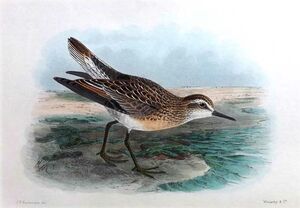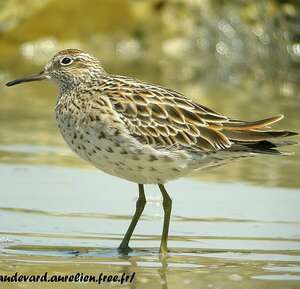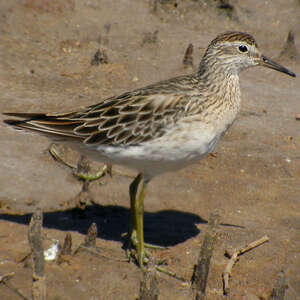Sharp-tailed Sandpiper
Calidris acuminata - Bécasseau à queue pointue
Identification
In breeding plumage, exceptional in Europe, the upper feathers are dark brown with broad reddish and off-white edging. Red cap. Light eyebrow widening in front of the eye. Neck and top of the chest heavily spotted with brown. Bottom of the chest, top of the belly and flanks marked with dark chevrons. In winter plumage, the bird appears more grayish, the neck and chest are less intensely spotted and the chevron pattern on the belly and flanks is practically invisible. The cap and eyebrow are still clearly visible.
The juveniles appear red (cap, neck, top of the chest, back). The sides and front of the neck are marked with thin dark streaks that are not very noticeable.
The color of the legs varies from yellow to yellow-olive or grayish olive. The beak, barely the same length as the head, is very slightly curved downwards. It is a fairly pale gray-brown.
This species is very close to the Spotted Sandpiper (see this sheet) which has a longer bill (yellowish base) and neck and whose chest is a more intense red in all plumages and, above all, in which this color is clearly separated from the white belly. In flight, the two species are very similar. The fingers protrude very slightly from the tail of the Sharp-tailed Sandpiper, not in the Spotted Sandpiper.
Subspecific information monotypic species
Foreign names
- Bécasseau à queue pointue,
- Correlimos acuminado,
- pilrito-acuminado,
- Spitzschwanz-Strandläufer,
- hegyesfarkú partfutó,
- Siberische Strandloper,
- Piovanello siberiano,
- spetsstjärtad snäppa,
- Spisshalesnipe,
- pobrežník ostrochvostý,
- jespák klínoocasý,
- Spidshalet Ryle,
- suippopyrstösirri,
- territ acuminat,
- Ósatíta,
- biegus ostrosterny,
- smailastes šņibītis,
- ostrorepi prodnik,
- Острохвостый песочник,
- Kedidi ekor-panjang,
- ウズラシギ,
- 尖尾滨鹬,
- นกชายเลนกระหม่อมแดง,
- 尖尾濱鷸,
Voice song and call
At take-off, a sharp trit-trit. Also a more melodious trrrt wiitiit sound reminiscent of certain cries from the Barn Swallow.
Habitat
During reproducting, the Sharp-tailed Sandpiper frequents very particular habitats, like wet tundra in low hilly terraines with sedges and mosses. Outside of its reproducting grounds, it becomes very ecletic and frequents almost all types of wet habitats, be they fresh, salty or brackish.
Behaviour character trait
Dietfeeding habits
Reproduction nesting
Reproduction is sometimes communal. Spectacular and noisy nuptial parades. The males emit crisp crackles that are not present in any other sharp-tailed sandpiper.
The nest is well hidden in the low vegetation. There are usually 4 eggs laid, which the female incubates alone while the male leaves the territory before they hatch.
Geographic range
The Sharp-tailed Sandpiper has a restricted distribution area, located in the extreme north of central-eastern Siberia. The species winters from Papua New Guinea to New Zealand and New Caledonia. Migrations occur on a very broad front from Lake Baikal to Japan. About fifty individuals were seen in Europe, of which about half in the British Isles. In France, up to 2002, only five observations have been recorded in Vendée (1972), Camargue (1999), Jura (2000), Ile-et-Vilaine and Pyrénées-Atlantiques (2001). It appears that these were individuals who had associated with Spotted Sandpipers during their crossing of North America and then the Atlantic.
Threats - protection
IUCN conservation status
concern
in the Wild
threatened
evaluated
This species does not seem to be threatened, but it is not known what the consequences of climate change may be on its environment. Its numbers are estimated to be around 160,000 individuals.
Sources of information
- IOC World Bird List (v15.1), Gill, F and D Donsker (Eds). 2025-12-07.
- Guide des limicoles d'Europe, d'Asie et d'Amérique du Nord, D. Taylor
- Le guide ornitho : Le guide le plus complet des oiseaux d'Europe, d'Afrique du Nord et du Moyen-Orient : 900 espèces, Svensson, Mullarney, Zetterstrom
- Limicoles, gangas et pigeons d'Europe, Paul Géroudet (mise à jour Georges Olioso)
- Nouvel inventaire des oiseaux de France, Philippe J. Dubois, Pierre Le Maréchal, Georges Olioso, Pierre Yésou
- Shorebirds, an identification guide to the waders of the world, Peter Hayman, John Marchant Tony Prater
- The Field Guide to the Birds of Australia, Graham Pizzey et Frank Knight
- The hand guide to the birds of New Zealand, Robertson Hugh et Heather Barrie
- The North American Bird Guide, David Sibley
- Vol. 6 - Handbook of the Birds of the World, Josep del Hoyo-Andrew Elliott-Jordi Sargatal
- Waterbird Population Estimates, Simon Delany Derek Scott
- Avibase, Lepage Denis
- New Zealand birds and birding, Narena Olliver
- The Birds of North America,
- Les oiseaux de Nouvelle Calédonie et des Loyauté, F Hannecart et Y Letocart
Other sources of interest
 Specification sheet created on
30/07/2023 by Georges Olioso
Specification sheet created on
30/07/2023 by Georges OliosoTranslation by AI Oiseaux.net
© 1996-2025 Oiseaux.net
- Accipitriformes
- Aegotheliformes
- Anseriformes
- Apodiformes
- Apterygiformes
- Bucerotiformes
- Caprimulgiformes
- Cariamiformes
- Casuariiformes
- Charadriiformes
- Ciconiiformes
- Coliiformes
- Columbiformes
- Coraciiformes
- Cuculiformes
- Eurypygiformes
- Falconiformes
- Galliformes
- Gaviiformes
- Gruiformes
- Leptosomiformes
- Mesitornithiformes
- Musophagiformes
- Nyctibiiformes
- Opisthocomiformes
- Otidiformes
- Passeriformes
- Pelecaniformes
- Phaethontiformes
- Phoenicopteriformes
- Piciformes
- Podargiformes
- Podicipediformes
- Procellariiformes
- Psittaciformes
- Pterocliformes
- Rheiformes
- Sphenisciformes
- Steatornithiformes
- Strigiformes
- Struthioniformes
- Suliformes
- Tinamiformes
- Trogoniformes





























